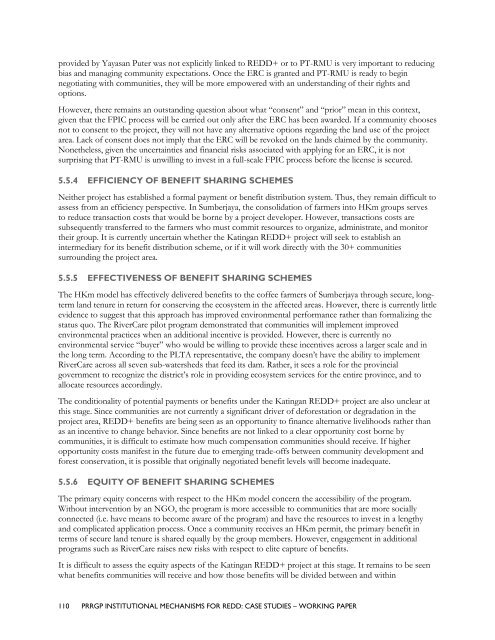Institutional Mechanisms for REDD+ - Case Studies Working Paper
Institutional Mechanisms for REDD+ - Case Studies Working Paper
Institutional Mechanisms for REDD+ - Case Studies Working Paper
Create successful ePaper yourself
Turn your PDF publications into a flip-book with our unique Google optimized e-Paper software.
provided by Yayasan Puter was not explicitly linked to <strong>REDD+</strong> or to PT-RMU is very important to reducing<br />
bias and managing community expectations. Once the ERC is granted and PT-RMU is ready to begin<br />
negotiating with communities, they will be more empowered with an understanding of their rights and<br />
options.<br />
However, there remains an outstanding question about what ―consent‖ and ―prior‖ mean in this context,<br />
given that the FPIC process will be carried out only after the ERC has been awarded. If a community chooses<br />
not to consent to the project, they will not have any alternative options regarding the land use of the project<br />
area. Lack of consent does not imply that the ERC will be revoked on the lands claimed by the community.<br />
Nonetheless, given the uncertainties and financial risks associated with applying <strong>for</strong> an ERC, it is not<br />
surprising that PT-RMU is unwilling to invest in a full-scale FPIC process be<strong>for</strong>e the license is secured.<br />
5.5.4 EFFICIENCY OF BENEFIT SHARING SCHEMES<br />
Neither project has established a <strong>for</strong>mal payment or benefit distribution system. Thus, they remain difficult to<br />
assess from an efficiency perspective. In Sumberjaya, the consolidation of farmers into HKm groups serves<br />
to reduce transaction costs that would be borne by a project developer. However, transactions costs are<br />
subsequently transferred to the farmers who must commit resources to organize, administrate, and monitor<br />
their group. It is currently uncertain whether the Katingan <strong>REDD+</strong> project will seek to establish an<br />
intermediary <strong>for</strong> its benefit distribution scheme, or if it will work directly with the 30+ communities<br />
surrounding the project area.<br />
5.5.5 EFFECTIVENESS OF BENEFIT SHARING SCHEMES<br />
The HKm model has effectively delivered benefits to the coffee farmers of Sumberjaya through secure, longterm<br />
land tenure in return <strong>for</strong> conserving the ecosystem in the affected areas. However, there is currently little<br />
evidence to suggest that this approach has improved environmental per<strong>for</strong>mance rather than <strong>for</strong>malizing the<br />
status quo. The RiverCare pilot program demonstrated that communities will implement improved<br />
environmental practices when an additional incentive is provided. However, there is currently no<br />
environmental service ―buyer‖ who would be willing to provide these incentives across a larger scale and in<br />
the long term. According to the PLTA representative, the company doesn‘t have the ability to implement<br />
RiverCare across all seven sub-watersheds that feed its dam. Rather, it sees a role <strong>for</strong> the provincial<br />
government to recognize the district‘s role in providing ecosystem services <strong>for</strong> the entire province, and to<br />
allocate resources accordingly.<br />
The conditionality of potential payments or benefits under the Katingan <strong>REDD+</strong> project are also unclear at<br />
this stage. Since communities are not currently a significant driver of de<strong>for</strong>estation or degradation in the<br />
project area, <strong>REDD+</strong> benefits are being seen as an opportunity to finance alternative livelihoods rather than<br />
as an incentive to change behavior. Since benefits are not linked to a clear opportunity cost borne by<br />
communities, it is difficult to estimate how much compensation communities should receive. If higher<br />
opportunity costs manifest in the future due to emerging trade-offs between community development and<br />
<strong>for</strong>est conservation, it is possible that originally negotiated benefit levels will become inadequate.<br />
5.5.6 EQUITY OF BENEFIT SHARING SCHEMES<br />
The primary equity concerns with respect to the HKm model concern the accessibility of the program.<br />
Without intervention by an NGO, the program is more accessible to communities that are more socially<br />
connected (i.e. have means to become aware of the program) and have the resources to invest in a lengthy<br />
and complicated application process. Once a community receives an HKm permit, the primary benefit in<br />
terms of secure land tenure is shared equally by the group members. However, engagement in additional<br />
programs such as RiverCare raises new risks with respect to elite capture of benefits.<br />
It is difficult to assess the equity aspects of the Katingan <strong>REDD+</strong> project at this stage. It remains to be seen<br />
what benefits communities will receive and how those benefits will be divided between and within<br />
110 PRRGP INSTITUTIONAL MECHANISMS FOR REDD: CASE STUDIES – WORKING PAPER

















